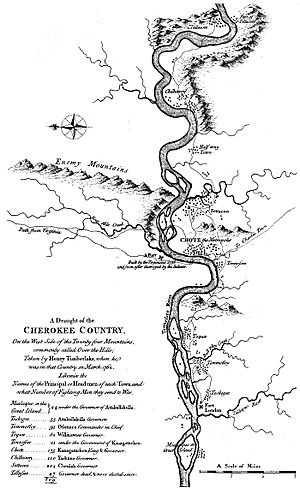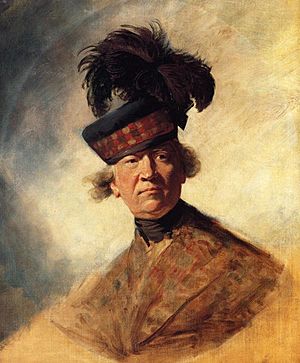Battle of Echoee facts for kids
Quick facts for kids Battle of Echoee |
|||||||
|---|---|---|---|---|---|---|---|
| Part of the Anglo-Cherokee War and the French and Indian War | |||||||
 Map of Cherokee Country by Henry Timberlake |
|||||||
|
|||||||
| Belligerents | |||||||
| Cherokee | |||||||
| Commanders and leaders | |||||||
| Seroweh | Archibald Montgomerie | ||||||
| Strength | |||||||
| 500 | 1,300–1,500 | ||||||
| Casualties and losses | |||||||
| 40 killed | 20 killed 76 wounded |
||||||
The Battle of Echoee, also known as Etchoe Pass, happened on June 27, 1760. It was a fight during the French and Indian War. British and colonial soldiers, led by Archibald Montgomerie, fought against Cherokee warriors. The Cherokee were led by Seroweh. The battle took place near what is now Otto, in Macon County, North Carolina.
Contents
Why the Battle Happened
When the French and Indian War started in 1754, the British wanted the Cherokee to be their friends. The Cherokee agreed to help fight against the French and their allies, the Shawnee. In return, the British promised to build two forts. These forts would protect Cherokee women, children, and towns.
The British built Fort Prince George in South Carolina. It was near the Cherokee's Lower Towns. They also built Fort Loudoun near the Overhill Towns in what is now Tennessee.
Early Problems
In 1756, a Cherokee leader named Ostenaco took 100 warriors to help British troops. After six weeks, the British ran out of supplies. The Cherokee were unhappy and decided to go home.
The next year, more Cherokee warriors joined a British army. This army was led by General John Forbes. Their goal was to force the French out of Fort Duquesne in Pennsylvania.
The British had trouble getting supplies to their allies. They had promised goods to the Native American warriors. But they didn't have enough. Many warriors started to leave by June 1758.
Growing Tensions
On their way home, some Cherokee took stray horses in Virginia. Virginia settlers got angry and attacked them. They killed 20 Cherokee people. The settlers even collected a British reward for killing enemies.
The governor of Virginia apologized. But some Virginians still thought the Cherokee were horse thieves. Some Cherokee leaders and warriors fought back. This made the situation much worse.
Things got even more serious at Fort Prince George. British colonists killed Cherokee leaders who were being held there as hostages. The Cherokee then attacked Fort Loudoun. The fighting continued into 1761.
Cherokee leaders like Standing Turkey and Oconostota led their people. The Cherokee tried to find allies among other tribes and the French. But they had to face the British alone.
War Declared
In 1759, the new governor of South Carolina, William Henry Lyttelton, declared war on the Cherokee. He stopped all gunpowder shipments to them. He also gathered an army of 1,100 troops.
The Cherokee needed gunpowder for hunting to survive the winter. They sent peace leaders to talk. But Governor Lyttelton took 32 of these leaders prisoner. He held them in a small room at Fort Prince George. He released only three, hoping for peace.
Lyttelton went back to Charleston. But the Cherokee attacked frontier settlements in 1760. In February 1760, they attacked Fort Prince George to free their hostages. The fort's commander was killed. His replacement then killed all the Cherokee hostages.
The Cherokee also attacked Fort Ninety Six, but it held strong. They surrounded Fort Loudoun. Several smaller British posts in the area quickly fell to Cherokee raids.
British Response
Governor Lyttelton asked for help from Jeffrey Amherst. Amherst was the top British commander in North America. Amherst sent Archibald Montgomerie with an army of 1,300 to 1,500 soldiers.
Montgomerie's army included 400 Royal Scots and 700 Montgomerie's Highlanders. He also had 300 Carolina rangers and 100 militia. About 40 to 50 Catawba warriors, who were rivals of the Cherokee, joined them.
The British wanted to defeat the Cherokee. They planned to burn their towns and crops. They also wanted to free the forts that the Cherokee were attacking.
In late May, the British reached Fort Ninety-Six. Montgomerie's army destroyed some Cherokee Lower Towns. These included Keowee, Estatoe, and Sugar Town. They killed or captured about 100 Cherokee. He then helped Fort Prince George and offered to talk. But most Cherokee warriors had moved to the Middle Towns. They no longer wanted to negotiate.
Montgomerie waited ten days. Then he prepared to march to the Middle Towns, about sixty miles away. The land was very difficult, with mountains and forests. He had to leave his wagons behind. They used horses to carry supplies instead.
The Battle
About five miles from Etchoe, the lowest town in the Cherokee's middle settlements, Montgomerie's lead group was attacked. This happened in a deep valley. Captain Morrison and many of his Rangers were killed.
Many Cherokee warriors had rifles. These guns were more accurate and had a longer range than the British muskets. The Cherokee aimed their shots carefully. The British fired without aiming much. The Rangers did not fight well. Many ran away when Captain Morrison was killed.
British Grenadier and Light infantry companies moved forward. They tried to help the Rangers. The Royal Scots moved to higher ground on the right side of the Cherokee. But heavy rifle fire pushed the Royal Scots back. They had to regroup and fight off a Cherokee counter-attack.
Montgomerie spread out his soldiers on the left. The Highlanders moved around the Cherokee's right side. The Cherokee then moved back and fought the Royal Scots in a quick battle. They retreated to a hill where they could not be moved.
Montgomerie ordered his troops to advance through the pass to the town. But some Cherokee ran to warn the townspeople to leave. Some warriors also got around Montgomerie's army. They attacked his supply animals and supplies. Losing these supplies would cripple the army. This attack was eventually stopped.
Montgomerie had many seriously wounded men. He could not leave them behind. Many supply animals were lost, making it hard to move forward. He had to stop his advance and leave many supplies. He needed the remaining horses to carry the wounded to safety.
The British army retreated to Fort Prince George. Montgomerie left supplies and his most badly wounded men there. He continued his retreat to Charleston. His mission partly succeeded in destroying the Cherokee Lower Towns. He also helped Fort Prince George. But he had to retreat from the Middle Towns. He failed to help Fort Loudoun in the Overhill country. By August, he and his men sailed back to New York.
What Happened Next
Because Montgomerie failed to help Fort Loudoun, the soldiers there had to give up. The Cherokee allowed Captain Demeré and his soldiers to keep their weapons. They could also keep enough ammunition to travel back to South Carolina. In return, they had to leave the rest of their weapons and ammunition for the Cherokee, led by Ostenaco.
The soldiers marched out of the fort on August 9, with a Cherokee escort. When the Cherokee entered the fort, they found hidden gunpowder and guns thrown into the river. This made the Cherokee angry because the agreement was broken. The next morning, the Cherokee attacked the soldiers in the woods. About 22 soldiers and 3 civilians were killed. This was the same number of Cherokee leaders killed at Fort Prince George. About 120 soldiers were taken prisoner.
People in Charleston were scared when they heard this news. The British and Cherokee made a six-month truce. But they could not agree on a lasting peace.
After a hard winter, the Cherokee were still determined. They had lost their harvest and had little ammunition for hunting. Many also got sick. But Jeffrey Amherst decided to launch a bigger invasion. He wanted to "punish the Cherokees" and make them ask for forgiveness.
James Grant led more British soldiers. He also had Native American scouts from the Mohawk and Stockbridge tribes. Catawba and Chickasaw warriors joined them. A large number of colonial troops also came. This group included future American Revolution heroes like William Moultrie and Francis Marion.
Grant's army had over 2,800 soldiers. They were ready for a long fight in the mountains and forests. They had a supply train a mile long. It had 600 horses carrying a month's food. They also had many cattle, managed by workers.
On June 10, 1761, Grant met 1,000 Cherokee warriors. This was near where the Battle of Echoee had happened before. The Cherokee again ambushed the British. They focused on killing the supply animals. After six hours of fighting from a distance, the Cherokee ran out of ammunition. They then pulled back.
Grant's army attacked and burned fifteen Middle Towns. They also destroyed all their crops. Grant ordered his troops to deal harshly with any Cherokee they captured. By July, Grant's men were exhausted. About 300 were too sick to walk. But he had badly damaged the Cherokee economy. About 4,000 people from the Middle Towns lost their homes and faced starvation.
In August 1761, the Cherokee asked for peace. Before the war in 1755, there were about 2,590 Cherokee warriors. After the war, this number was reduced to 2,300 due to battles, disease, and starvation.
Images for kids




